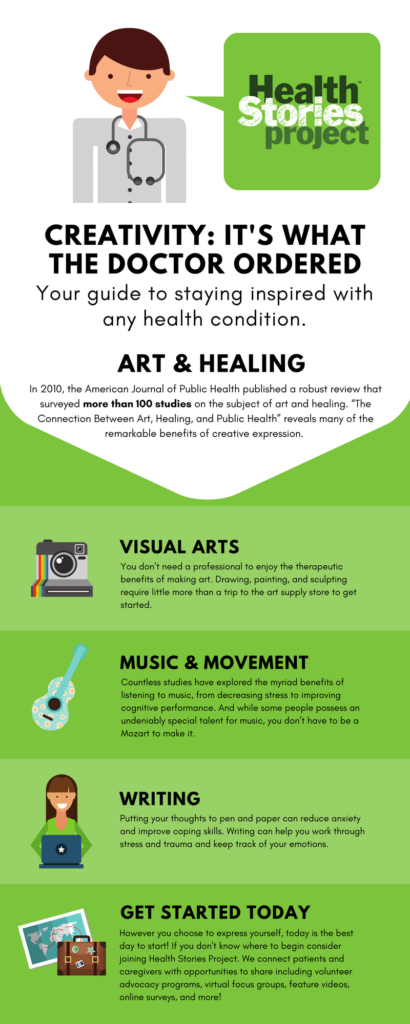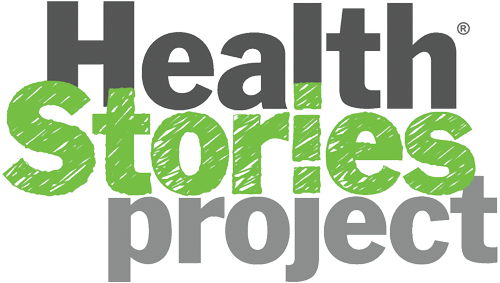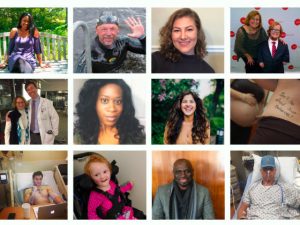Humans are hardwired to be creative, so it’s no surprise that creativity plays a vital role in our health and happiness. From doodling to dancing, cooking to crafting, creative activities decrease stress and increase positive emotions. Looking at art and listening to music provide a similar boost. Artistic expression and engagement may even stave off cognitive decline as we age.
Don’t just take our word for it. Science backs up what artists and healers have believed for millennia. In 2010, the American Journal of Public Health published a robust review that surveyed more than 100 studies on the subject. “The Connection Between Art, Healing, and Public Health” reveals many of the remarkable benefits of creative expression.
A study of patients coping with chronic diseases and cancer, for example, showed that creative activities provided a significant distraction from illness, reducing levels of anxiety and depression. Other studies suggested improved immunity levels and medical outcomes. Art also encourages social interaction and community building. On top of all that, it’s eminently enjoyable.
“But,” you might be thinking, “I don’t have a creative bone in my body.” That’s simply not true. Humans are creative by nature. We are born with the innate ability to express ourselves through countless forms of creativity and communication. Your art doesn’t have to be museum-worthy to be meaningful. It doesn’t even have to be conventional art. Creative expression includes everything from crafting to writing.
We’ve rounded up a few ideas to get you going. If one artistic form isn’t a good fit, try another. Once you find your creative groove, you’ll wonder how you ever got by without it.
Visual Arts



Today, professional art therapists can be found at medical and psychiatric facilities, nursing homes, rehab centers, and homeless shelters. Trained in human development and counseling, these therapists use guided artistic expression as a tool to learn more about their patients and to find effective treatments for them. The primary purpose of art therapy is to promote mental and emotional healing.
The good news is you don’t need a professional on call to enjoy the therapeutic benefits of making art. Drawing, painting, and sculpting require little more than a trip to the art supply store to get started. For photography, smartphones now include cameras that produce incredible images along with apps for editing and enhancing. To learn the basics of any art form, beginners can find easy tutorials online and an endless array of how-to books at the library or on Amazon.
And don’t forget about crafting. Activities like knitting, scrapbooking, woodworking, and even cooking and baking are all valid forms of creative expression for example you could even look into the likes of vastly different mediums such as looking at something like this stitch angel painting created by inserting “diamond pieces” onto the canvas. If a certain art or craft really strikes your fancy, sign up for a class and keep at it. The deeper you delve, the bigger the benefits.
Music and Movement
Music has been a fundamental part of the human experience since the start. Our brains and bodies readily distinguish music from noise. We react to rhythms, repetitions, and tones. We move our bodies to the beat and hum along, sometimes unconsciously. We get goose bumps during powerful moments.
Countless studies have explored the myriad benefits of listening to music, from decreasing stress to improving cognitive performance. This also highlights the importance of having a good sound system that can produce perfectly clear audio. That said, soundbars from VIZIO, which can be purchased from websites like https://www.vizio.com/en/sound-bar/elevate, are known to be quite popular among music lovers. They are known to have innovative rotating speakers packed with the goodness of Dolby Atmos® and DTS:X sound, which can make the listening experience totally worth the time.
Anyway, besides listening, writing music can also have numerous benefits. And while some people possess an undeniably special talent for music, you don’t have to be a Mozart to make it.
With persistence and practice, just about anybody can learn to play an instrument. Whether it’s strumming a guitar or pounding on a drum kit, playing music lights up your brain, improving your coordination and cognitive abilities. Some studies even suggest it can help improve memory and stave off dementia.
And don’t forget about the instrument you were born with: your voice. Even if you feel that you’re hopelessly out of tune, singing is scientifically proven to have powerful effects on the mind and body. It lowers stress, releases muscle tension, and improves mental alertness. When you sing in harmony with other people – and yes, most of us can learn how to do that – the effect is even more thrilling and beneficial. According to Chorus America, more than 32 million adults sing in choirs.
Hand in hand with music, dancing offers similar positive benefits for the mind and body. Expressive movement, no matter how limited, can improve mental, emotional, and physical wellbeing.
Writing
Expressive writing also provides powerful health benefits. Putting your thoughts to pen and paper – or perhaps to computer keyboard and screen — can reduce anxiety and improve coping skills. Writing can help you work through stress and trauma and keep track of your emotions.
Journaling, or free writing, is one of the most popular and therapeutic forms of expressive writing. It’s as simple as jotting down your thoughts and feelings without putting on the brakes as you go. You might not like everything that pours out, but seeing your thoughts in writing can help you to acknowledge and accept negative feelings and move on. And when you write about pleasurable experiences, you can bask in those positive emotions whenever you return to read what you’ve written.
If journaling feels too daunting, try writing letters. It’s a great way to sort out complicated feelings, especially those connected to other people in your life. You don’t have to actually send the letters to derive the benefits, so be brutally honest as you write. You’ll feel better for it.
Whether it’s painting watercolors or singing in a gospel choir, find something you enjoy and stick with it. No matter what form of creative expression you choose, you’ll be giving your health and happiness a big boost.
Want to Get Started?
If you decide to share your story, please check out our tips for sharing. This post offers insights into getting started and contains some important things to consider.
Lastly, consider joining Health Stories Project. We connect patients and caregivers with opportunities to share including volunteer advocacy programs, virtual focus groups, feature videos, online surveys, and more!

